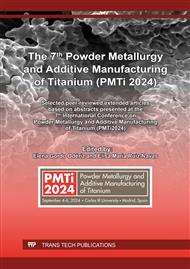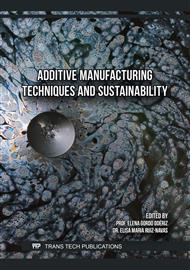[1]
S. Mellor, L. Hao, D. Zhang, Additive manufacturing: A framework for implementation, International Journal of Production Economics 149 (2014) 194–201.
DOI: 10.1016/j.ijpe.2013.07.008
Google Scholar
[2]
J.J. Lewandowski, M. Seifi, Metal Additive Manufacturing: A Review of Mechanical Properties, Annual Review of Materials Research 46 (2016) 151–186.
DOI: 10.1146/annurev-matsci-070115-032024
Google Scholar
[3]
S.R. Narasimharaju, W. Zeng, T.L. See, Z. Zhu, P. Scott, X. Jiang, S. Lou, A comprehensive review on laser powder bed fusion of steels: Processing, microstructure, defects and control methods, mechanical properties, current challenges and future trends, Journal of Manufacturing Processes 75 (2022) 375–414.
DOI: 10.1016/j.jmapro.2021.12.033
Google Scholar
[4]
W.E. Frazier, Metal Additive Manufacturing: A Review, J. of Materi Eng and Perform 23 (2014) 1917–1928.
DOI: 10.1007/s11665-014-0958-z
Google Scholar
[5]
S. Yang, Y.F. Zhao, Additive manufacturing-enabled design theory and methodology: a critical review, Int J Adv Manuf Technol 80 (2015) 327–342.
DOI: 10.1007/s00170-015-6994-5
Google Scholar
[6]
M. Laleh, E. Sadeghi, R.I. Revilla, Q. Chao, N. Haghdadi, A.E. Hughes, W. Xu, I. De Graeve, M. Qian, I. Gibson, M.Y. Tan, Heat treatment for metal additive manufacturing, Progress in Materials Science 133 (2023) 101051.
DOI: 10.1016/j.pmatsci.2022.101051
Google Scholar
[7]
H.-H. König, N.H. Pettersson, A. Durga, S. Van Petegem, D. Grolimund, A.C. Chuang, Q. Guo, L. Chen, C. Oikonomou, F. Zhang, G. Lindwall, Solidification modes during additive manufacturing of steel revealed by high-speed X-ray diffraction, Acta Materialia 246 (2023) 118713.
DOI: 10.1016/j.actamat.2023.118713
Google Scholar
[8]
Standard Specification for Wrought Titanium-6Aluminum-4Vanadium ELI (Extra Low Interstitial) Alloy for Surgical Implant Applications (UNS R56401), (n.d.). https://www.astm.org/f0136-13r21e01.html (accessed March 23, 2024).
DOI: 10.1520/f0136-98e01
Google Scholar
[9]
A. Gutierrez, M. Hahn, Y.-J. Li, A. Dehbozorgi, W. Hohorst, M. Schwartz, J. Orlita, Y.T. Hein, N. Guanzon, X. Sun, O.S. Es-Said, The Effect of Different Annealing Conditions on the Anisotropy of the Fracture Toughness of Ti-6Al-4V, J. of Materi Eng and Perform 28 (2019) 7155–7164.
DOI: 10.1007/s11665-019-04449-6
Google Scholar
[10]
A. Leicht, M. Fischer, U. Klement, L. Nyborg, E. Hryha, Increasing the Productivity of Laser Powder Bed Fusion for Stainless Steel 316L through Increased Layer Thickness, J. of Materi Eng and Perform 30 (2021) 575–584.
DOI: 10.1007/s11665-020-05334-3
Google Scholar
[11]
F. Deirmina, O. Adegoke, M.D. Col, M. Pellizzari, Effect of layer thickness, and laser energy density on the recrystallization behavior of additively manufactured Hastelloy X by laser powder bed fusion, Additive Manufacturing Letters 7 (2023) 100182.
DOI: 10.1016/j.addlet.2023.100182
Google Scholar
[12]
C. Pauzon, A. Raza, I. Hanif, S. Dubiez-Le Goff, J. Moverare, E. Hryha, Effect of layer thickness on spatter properties during laser powder bed fusion of Ti–6Al–4V, Powder Metallurgy 66 (2023) 333–342.
DOI: 10.1080/00325899.2023.2192036
Google Scholar
[13]
A. Raza, C. Pauzon, S. Dubiez-Le Goff, E. Hryha, Effect of processing gas on spatter generation and oxidation of TiAl6V4 alloy in laser powder bed fusion process, Applied Surface Science 613 (2023) 156089.
DOI: 10.1016/j.apsusc.2022.156089
Google Scholar
[14]
Q.B. Nguyen, D.N. Luu, S.M.L. Nai, Z. Zhu, Z. Chen, J. Wei, The role of powder layer thickness on the quality of SLM printed parts, Archiv.Civ.Mech.Eng 18 (2018) 948–955.
DOI: 10.1016/j.acme.2018.01.015
Google Scholar
[15]
M.A. Spurek, L. Haferkamp, C. Weiss, A.B. Spierings, J.H. Schleifenbaum, K. Wegener, Influence of the particle size distribution of monomodal 316L powder on its flowability and processability in powder bed fusion, Prog Addit Manuf 7 (2022) 533–542.
DOI: 10.1007/s40964-021-00240-z
Google Scholar
[16]
200-315 Abstracts, (n.d.). https://www.mpif.org/Events/PowderMet2021/Program/ TechnicalSession/Monday/200-315/200-315Abstracts.aspx (accessed March 23, 2024).
Google Scholar
[17]
G. Soundarapandiyan, C. Johnston, R.H.U. Khan, C.L.A. Leung, P.D. Lee, E. Hernández-Nava, B. Chen, M.E. Fitzpatrick, The effects of powder reuse on the mechanical response of electron beam additively manufactured Ti6Al4V parts, Additive Manufacturing 46 (2021) 102101.
DOI: 10.1016/j.addma.2021.102101
Google Scholar
[18]
L. Thijs, F. Verhaeghe, T. Craeghs, J.V. Humbeeck, J.-P. Kruth, A study of the microstructural evolution during selective laser melting of Ti–6Al–4V, Acta Materialia 58 (2010) 3303–3312.
DOI: 10.1016/j.actamat.2010.02.004
Google Scholar
[19]
B. Vrancken, L. Thijs, J.-P. Kruth, J. Van Humbeeck, Heat treatment of Ti6Al4V produced by Selective Laser Melting: Microstructure and mechanical properties, Journal of Alloys and Compounds 541 (2012) 177–185.
DOI: 10.1016/j.jallcom.2012.07.022
Google Scholar



